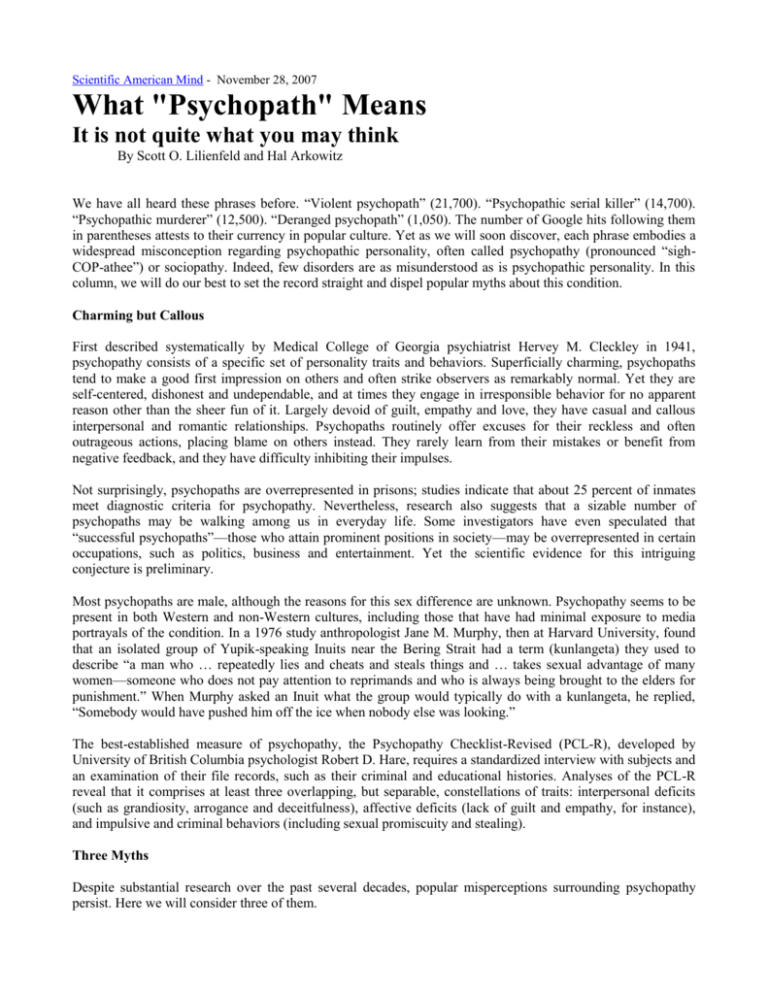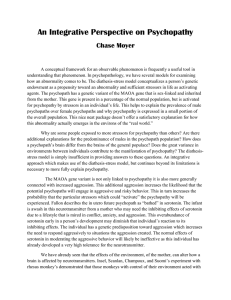
Scientific American Mind - November 28, 2007
What "Psychopath" Means
It is not quite what you may think
By Scott O. Lilienfeld and Hal Arkowitz
We have all heard these phrases before. “Violent psychopath” (21,700). “Psychopathic serial killer” (14,700).
“Psychopathic murderer” (12,500). “Deranged psychopath” (1,050). The number of Google hits following them
in parentheses attests to their currency in popular culture. Yet as we will soon discover, each phrase embodies a
widespread misconception regarding psychopathic personality, often called psychopathy (pronounced “sighCOP-athee”) or sociopathy. Indeed, few disorders are as misunderstood as is psychopathic personality. In this
column, we will do our best to set the record straight and dispel popular myths about this condition.
Charming but Callous
First described systematically by Medical College of Georgia psychiatrist Hervey M. Cleckley in 1941,
psychopathy consists of a specific set of personality traits and behaviors. Superficially charming, psychopaths
tend to make a good first impression on others and often strike observers as remarkably normal. Yet they are
self-centered, dishonest and undependable, and at times they engage in irresponsible behavior for no apparent
reason other than the sheer fun of it. Largely devoid of guilt, empathy and love, they have casual and callous
interpersonal and romantic relationships. Psychopaths routinely offer excuses for their reckless and often
outrageous actions, placing blame on others instead. They rarely learn from their mistakes or benefit from
negative feedback, and they have difficulty inhibiting their impulses.
Not surprisingly, psychopaths are overrepresented in prisons; studies indicate that about 25 percent of inmates
meet diagnostic criteria for psychopathy. Nevertheless, research also suggests that a sizable number of
psychopaths may be walking among us in everyday life. Some investigators have even speculated that
“successful psychopaths”—those who attain prominent positions in society—may be overrepresented in certain
occupations, such as politics, business and entertainment. Yet the scientific evidence for this intriguing
conjecture is preliminary.
Most psychopaths are male, although the reasons for this sex difference are unknown. Psychopathy seems to be
present in both Western and non-Western cultures, including those that have had minimal exposure to media
portrayals of the condition. In a 1976 study anthropologist Jane M. Murphy, then at Harvard University, found
that an isolated group of Yupik-speaking Inuits near the Bering Strait had a term (kunlangeta) they used to
describe “a man who … repeatedly lies and cheats and steals things and … takes sexual advantage of many
women—someone who does not pay attention to reprimands and who is always being brought to the elders for
punishment.” When Murphy asked an Inuit what the group would typically do with a kunlangeta, he replied,
“Somebody would have pushed him off the ice when nobody else was looking.”
The best-established measure of psychopathy, the Psychopathy Checklist-Revised (PCL-R), developed by
University of British Columbia psychologist Robert D. Hare, requires a standardized interview with subjects and
an examination of their file records, such as their criminal and educational histories. Analyses of the PCL-R
reveal that it comprises at least three overlapping, but separable, constellations of traits: interpersonal deficits
(such as grandiosity, arrogance and deceitfulness), affective deficits (lack of guilt and empathy, for instance),
and impulsive and criminal behaviors (including sexual promiscuity and stealing).
Three Myths
Despite substantial research over the past several decades, popular misperceptions surrounding psychopathy
persist. Here we will consider three of them.
1. All psychopaths are violent. Research by psychologists such as Randall T. Salekin, now at the
University of Alabama, indicates that psychopathy is a risk factor for future physical and sexual
violence. Moreover, at least some serial killers—for example, Ted Bundy, John Wayne Gacy and
Dennis Rader, the infamous “BTK” (Bind, Torture, Kill) murderer—have manifested numerous
psychopathic traits, including superficial charm and a profound absence of guilt and empathy.
Nevertheless, most psychopaths are not violent, and most violent people are not psychopaths. In the days
following the horrific Virginia Tech shootings of April 16, 2007, many newspaper commentators described the
killer, Seung-Hui Cho, as “psychopathic.” Yet Cho exhibited few traits of psychopathy: those who knew him
described him as markedly shy, withdrawn and peculiar.
Regrettably, the current (fourth, revised) edition of the American Psychiatric Association’s Diagnostic and
Statistical Manual of Mental Disorders Text Revision (DSM-IV-TR), published in 2000, only reinforces the
confusion between psychopathy and violence. It describes a condition termed antisocial personality disorder
(ASPD), which is characterized by a longstanding history of criminal and often physically aggressive behavior,
referring to it as synonymous with psychopathy. Yet research demonstrates that measures of psychopathy and
ASPD overlap only moderately.
2. All psychopaths are psychotic. In contrast to people with psychotic disorders, such as schizophrenia,
who often lose contact with reality, psychopaths are almost always rational. They are well aware that
their ill-advised or illegal actions are wrong in the eyes of society but shrug off these concerns with
startling nonchalance.
Some notorious serial killers referred to by the media as psychopathic, such as Charles Manson and David
Berkowitz, have displayed pronounced features of psychosis rather than psychopathy. For example, Manson
claimed to be the reincarnation of Jesus Christ, and Berkowitz believed he was receiving commands from his
neighbor Sam Carr’s dog (hence his adopted nickname “Son of Sam”). In contrast, psychopaths are rarely
psychotic.
3. Psychopathy is untreatable. In the popular HBO series The Sopranos, the therapist (Dr. Melfi)
terminated psychotherapy with Tony Soprano because her friend and fellow psychologist persuaded her
that Tony, whom Dr. Melfi concluded was a classic psychopath, was untreatable. Aside from the fact
that Tony exhibited several behaviors that are decidedly nonpsychopathic (such as his loyalty to his
family and emotional attachment to a group of ducks that had made his swimming pool their home), Dr.
Melfi’s pessimism may have been unwarranted. Although psychopaths are often unmotivated to seek
treatment, research by psychologist Jennifer Skeem of the University of California, Irvine, and her
colleagues suggests that psychopaths may benefit as much as nonpsychopaths from psychological
treatment. Even if the core personality traits of psychopaths are exceedingly difficult to change, their
criminal behaviors may prove more amenable to treatment.
Psychopathy reminds us that media depictions of mental illness often contain as much fiction as fact. Moreover,
widespread misunderstandings of such ailments can produce unfortunate consequences—as Tony Soprano
discovered shortly before the television screen went blank.












